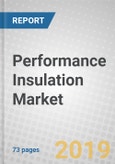Report Scope:
The scope of this report includes an analysis of the insulation products and materials markets. This report includes products and materials that typically are used in extreme conditions like high temperatures or which provide enhanced properties beyond those offered by traditional insulations.
This report analyzes the following high-performance products and materials:
- Aerogel.
- Ceramic fiber.
- Fiber glass.
- High-performance foams.
- Vacuum-insulated panels.
- Insulation bulk fibers/fiber boards and shapes.
- Insulating papers.
- High-performance foam adhesive dressing.
- Rigid/structural foam.
- Spray foam roof insulation
This report analyzes market trends for these products and materials and provides perspective for their end-use industries. This report discusses industries such as oil and gas, industrial, thermal and acoustic insulation, electronics and optoelectronics, chemical/mechanical/environmental, life science and personal care, sensors and instrumentation, energy, aerospace and space exploration, consumer products, defense, and others. This report also provides estimates and forecasts for revenue forecasts for aerogel, ceramic fiber, fiber glass, and high-performance foams.
This report focuses on the top 10 companies of the high-performance insulation market and the key areas in the field driving industry growth. This report also explores industry structure, noting strategic alliances and acquisitions.
This report analyzes global market trends, with data from 2017 to 2023 and projects compound annual growth rates (CAGR) for the period from 2018 to 2023. Estimated values used are based on manufacturers’ total revenues. Projected and forecasted revenue values are in constant U.S. dollars, unadjusted for inflation.
The Report Includes:
- Detailed overview of the global market for high-performance insulation materials within the industry
- Analyses of the global market trends, with data from 2017 and 2018, and projections of compound annual growth rates (CAGRs) through 2023
- A brief insight into the introduction of new materials and fabrication methods that will lead to reduced production costs and, ultimately, lower unit prices
- Information on underlying technologies driving the industry’s growth along with primary factors - current trends, regulatory updates, and other macro-economic factors - that can influence the market
- Assessment of vendor landscape focused on selected top ten companies in the insulation market, their market strategies, business segments, product portfolios, and financial performance
- Profile description of leading top ten high-performance insulation companies
Table of Contents
Samples

LOADING...
Executive Summary
Insulation is defined as a complete barrier or shield that prevents the transfer of heat through floors, ceilings, and walls by trapping it into small cavities. These small cavities regulate indoor temperature, create a healthier and comfortable living environment and save energy. Also, smaller cavities in insulation material perform better than larger cavities and can lead to an effective thermal barrier. Insulation materials achieve their effectiveness through density, low thermal conductivity, the thickness of insulation, thermal bridging and surface emissivity. These properties enhance the functioning and performance of insulating materials. The high-performance insulation material usually depends on the raw material type that is used, and the manufacturing process that takes place along with the skilled labor force.
Thermal and acoustic insulation is the largest segment of the high-performance insulation market. Industrial thermal insulation leads the market followed by thermal insulation for residential buildings and thermal insulation for commercial buildings.
In the current market, industrial, residential and commercial builders face myriad options for improving building energy efficiency that includes high-performance insulation, energy-efficient equipment, and a growing cadre of smart systems and controls. When seeking green building certification or simply higher energy efficiency construction, cost-effectiveness and multiple benefits become critical factors in selecting energy-efficient, green technologies. High-performance insulation includes a group of rapidly growing multi-benefit residential and commercial building technologies designed to improve insulation capacity while advancing building strength.
High-performance insulation materials also can provide other important benefits, including reduced installation costs, exceptionally fast framing, reduced weight, disaster resistance, and reduced sound penetration, which provides an opportunity for growth, development and increased market penetration. Some technologies like insulated concrete blocks/masonry units offer the advantage as nearly drop-in replacements for existing building technologies. This greatly lowers risk and limits the need for extensive worker training and expertise. In contrast, SIPs and especially ICFs require skilled, experienced installers to ensure proper application. Many regions are approaching a critical mass of such skilled labor requirement, which is slowing market development.
Aerogel is a type of raw material used to manufacture insulation materials which are a thousand times less dense than glass and are environmentally friendly. High-performance insulation materials deliver forty times more insulation than the fiberglass and can be used at temperatures between -200°C and 650°C.
Aerogels are ultra-light, low-density and nano-porous materials. In the past decade, they have generated significant interest in their use in high-performance applications. Although originally produced as silica monoliths, aerogel technology has evolved, and current aerogels are commercially available in a variety of materials, shapes, and sizes to meet the requirements of a broader number of applications.
Companies Mentioned
- 3M
- Aerogel Technologies Llc
- Aspen Aerogels Inc.
- Cabot Corp.
- Guangdong Alison High-Tech
- Ibiden Co., Ltd.
- Isolite Insulating Products Co., Ltd.
- Morgan Advanced Materials
- Nano Tech Co., Ltd.
- Unifrax Llc








